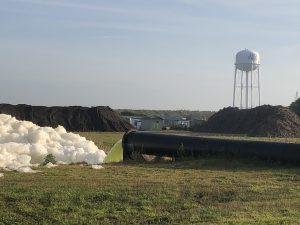
Tracking the impacts of Piney Point discharge on Tampa Bay
This NSF-funded project will investigate the impacts of nutrients released from Piney Point on ecosystems and phytoplankton communities within Tampa Bay. In collaboration with Drs. Ed Phlips, we are studying changes in nutrient cycling and phytoplankton communities in Tampa Bay. These data will be coupled with long-term seagrass monitoring conducted by Tampa Bay Estuary Program, and is also being conducted in collaboration with Drs. Andrew Altieri and Christine Angelini (UF, ESSIE).
Indicators of anthropogenic contamination in coastal systems
The diversity of anthropogenic impacts to coastal systems call for multiple indicators of anthropogenic contamination. Pulses of organic matter, and associated contaminants, can be transported during extreme events, such as hurricanes. Fecal sterols can be a useful tool to identify sources of contamination within coastal systems and ongoing work is being conducted to quantify changes in fecal sterols and stable isotopes over the course of a hurricane to evaluate their utility in tracking changes in water quality.

Organic matter cycling in treatment wetlands
We are using a combination of chemical biomarkers, including amino acids, pigments, and lignin, to evaluate how vegetation communities and management strategies influence the sources and turnover of organic matter in treatment wetlands and how it relates to phosphorus biogeochemistry. Funded by the South Florida Water Management District.
 Priming and the fate of blue carbon
Priming and the fate of blue carbon
Blue carbon, or the carbon sequestered in coastal environments, has been recognized as an important carbon sink, but our understanding of it’s fate when it’s exported into coastal waters is incomplete. Priming, or the enhanced degradation of refractory carbon when in the presence of a labile substrate, could be a mechanism of blue C loss in coastal systems. We use a variety of approaches, including metagenomics, metatranscriptomics, and high resolution mass spectrometry to evaluate the changes in microbial communities and organic matter under priming conditions. In collaboration with Dr. Thomas S. Bianchi (UF Geological Sciences), Nick Ward (Pacific Northwest National Lab) and Dr. Todd Osborne (Whitney Marine Laboratory).
 Herbivore impacts on salt marsh biogeochemistry
Herbivore impacts on salt marsh biogeochemistry
Recent increases in Sesarma reticulatum populations throughout the south-eastern United States have resulted the loss of salt marsh vegetation and alterations in soil processes. We’re using biomarkers to evaluate differences in organic matter quality between grazed and healthy creeks, and are investigating how these landscape features have changed over time to determine how herbivore outbreaks may impact salt marsh resilience. In collaboration with Dr. Christine Angelini (UF, ESSIE).
